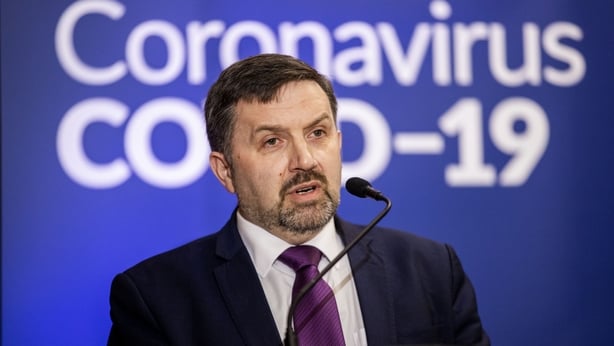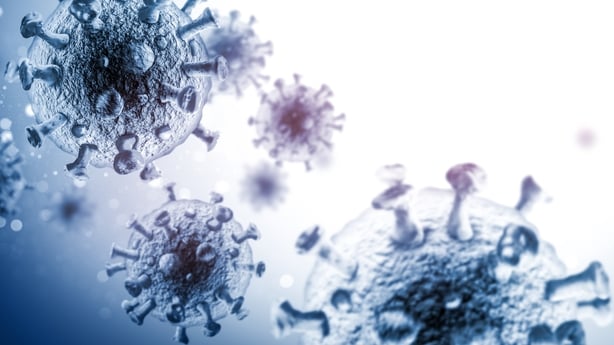Five further Covid-19 linked deaths have been reported in Northern Ireland and 1,039 new cases of the virus, the Department of Health has announced.
The death toll now stands at 629.
There have been 29,992 confirmed cases, 6,791 in the last seven days.
The seven-day infection rate per 100,000 people for Northern Ireland is 360.9.
The rate in Derry and Strabane is 669.7, with Belfast on 509.9, followed by Mid Ulster on 455.5, and Antrim and Newtownabbey on 314.0.
There are 289 patients with Covid-19 being treated in hospital, 32 of whom are in intensive care.
Stormont Health Minister Robin Swann said the rate of increase of cases has "slowed considerably" from last week.
However, Mr Swann said the virus had been "growing exponentially in our society with potentially catastrophic consequences for many individuals and families as well as our own health service and indeed our own economy".
He said within days Northern Ireland will exceed the highest number of hospital admissions experienced in the first wave of the pandemic, adding: "This is how grave our current situation is."
Mr Swann has received a close-proximity notification from Northern Ireland's track and trace app.
In a tweet, he confirmed the news and said he will be working from self-isolation for the next 14 days.
We are all in this together.
— Robin Swann MLA : #StopCovidNI (@RobinSwannMoH) October 21, 2020
Earlier this evening I received a close proximity notification via our StopCOVID NI App, so I will be working from self isolation for the next 14 days.
Download #StopCovidNI help break the infection chain...
Earlier, defending tougher restrictions introduced last week, Mr Swann said: "Sitting back and letting Covid rip unchecked through our community would have been a total abdication of responsibility."
"Restricting human contacts is a proven way of fighting back at Covid-19," he added.
"If we are not going for a full lockdown then restrictions have to be targeted, however complicated that may be, because I have yet to see any real or feasible alternatives to the action that we are now taking.
83 care homes in Northern Ireland have confirmed Covid-19 outbreaks.
"This is a huge concern to me and should be to everyone," Mr Swann said.
"The blunt truth is that widespread community transmission makes it increasingly hard to keep care homes safe.

"We cannot throw a ring of steel around homes and cut them off entirely from the wider community because quality of life must be balanced with protection of life.
"However, there are steps that we can take and, following the rapid learning initiative that was led by our chief nursing officer, our care home surge plan has been updated and refreshed."
Mr Swann announced plans for an additional £27 million of funding for care homes to support the costs of the Covid-19 testing programme.
He also paid tribute to the work of care staff and said his department is finalising a business case for increased pay for the sector.
Northern Ireland's chief scientist defends business closures
Northern Ireland's chief scientist has defended the evidence base that guided ministerial decisions to shut sections of the economy.
The closure of a range of businesses has been questioned after it emerged ministers were advised the move would have a low to moderate impact on infection rates but a high economic impact on workers.
The scientific paper estimated the closure of hairdressers and beauticians could reduce the virus's reproduction number (R number) by 0.05 while the closure of pubs and restaurants could decrease R by between 0.1 to 0.2.
Chief Scientific Adviser Professor Ian Young said the numbers might appear small but such incremental reductions could make an "enormous difference".
Prof Young highlighted that R is currently around 1.4 in Northern Ireland and the aim of the current four-week circuit-break is to reduce the number by 0.5, to below one.
In that context, 0.05 is 10% of the reduction ministers are trying to achieve and 0.2 is 40%.
He said: "Even these small numbers, particularly when R is close to one, can have an enormous difference.
"We need for this period all of the levers that we can get to achieve the impact that we need."
The data is contained in a scientific paper that guided the Stormont Executive's recent decisions on the introduction of the circuit-break.

The paper, which is a summary of advice drawn up by the Scientific Advisory Group for Emergencies (Sage), was published yesterday as part of an initiative by the Department of Health to increase transparency around the decision-making process.
The paper listed a range of actions available to ministers, setting out the impact of each both on transmission rates and on wider society.
Last week, close contact services such as hairdressers and beauticians were among a range of businesses required to close until 13 November.
While the Executive paper said shutting close contact services would have a low impact on Covid-19 transmission - a potential reduction in R by 0.05 - it would have a high social and economic impact, warning it would disproportionately affect low-income workers and women.
Other steps that would have had a greater projected impact on R - such as the closure of churches (estimated reduction of 0.1) - were not taken.
The paper's advice that the current closure of bars, pubs, cafes and restaurants is likely to have a "moderate impact" - reducing R by between 0.1 and 0.2 - referenced multiple "anecdotal reports" of outbreaks linked to bars in the UK and beyond.
The paper said a curfew, which ministers introduced last month, is likely to have a "marginal impact".
In terms of the non-Covid impact, the paper again warned of a high impact caused by a loss of income for hospitality workers.
Simon Hamilton, chief executive of business representative body Belfast Chamber, branded the evidence "flimsy" and said the paper poses "massive questions" for the Executive.
He tweeted: "Why did ministers close hospitality and close contact retail when they knew it would have such a low impact on the R number, a high impact (on) incomes and a disproportionate effect on the poor and women?"
Mr Hamilton, a former DUP health and economy minister in the Executive, described the evidence as "absolutely shocking".
This flimsy evidence poses massive questions for the @niexecutive. Why did Ministers close hospitality and close contact retail when they knew it would have such a low impact on the R number, a high impact incomes and a disproportionate effect on the poor and women? 6/6
— Simon Hamilton (@SimonHamilton) October 20, 2020
On the closure of pubs and restaurants, Prof Young said: "We need to get it (R) down by 0.5, it sounds like a small number but 0.2 - and may be more than that for pubs and restaurants - is 40% of the way and we don't have a lot of levers left to pull, so every little bit that we can get is going to play a role in making sure that R is less than one rather than over one."
On the estimated impact on R of closing close contact services, the chief scientific adviser added: "0.05 doesn't sound like much, but if we end up with an R of 0.98 then cases will decline and pressure on hospitals will reduce.
"If R is 1.03 - just 0.05 higher - cases will continue to increase and expand and the impact of that over the course of a few weeks would be a couple of hundred cases."
The Executive paper said the closure of all schools would have a "moderate impact" on R, reducing it by between 0.2 and 0.5.
It said the non-Covid impact would be high due to the disruption to young people's education. Schools are currently closed for two weeks after the mid-term Halloween break was extended by a week.
The paper said the move that would have the greatest impact on transmission would be the reintroduction of a stay-at-home order similar to the first lockdown.
It said that move had been shown to reduce R from 2.7 to 0.6 during the first lockdown.
The evidence bank includes multiple reports from Sage, weekly papers on the R number in Northern Ireland, and a variety of other expert assessments.

